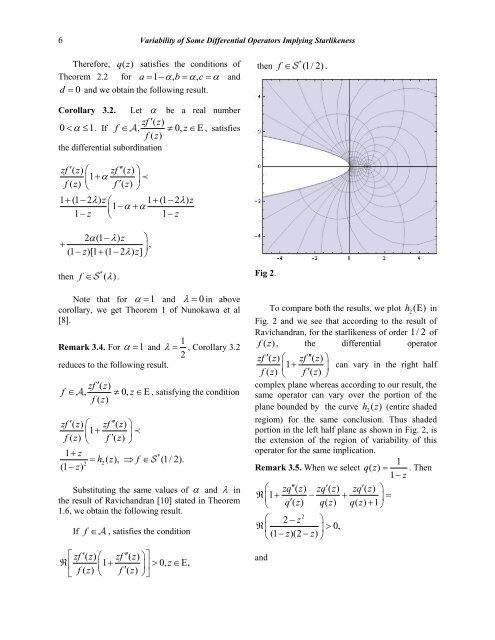TITLE MARCH 2012 - Pakistan Academy of Sciences
TITLE MARCH 2012 - Pakistan Academy of Sciences
TITLE MARCH 2012 - Pakistan Academy of Sciences
Create successful ePaper yourself
Turn your PDF publications into a flip-book with our unique Google optimized e-Paper software.
6 Variability <strong>of</strong> Some Differential Operators Implying Starlikeness<br />
Therefore, qz () satisfies the conditions <strong>of</strong><br />
Theorem 2.2 for a 1 , b ,<br />
c and<br />
d 0 and we obtain the following result.<br />
Corollary 3.2. Let be a real number<br />
zf ()<br />
z<br />
0<br />
1. If f , 0,<br />
z E , satisfies<br />
f(<br />
z)<br />
the differential subordination<br />
zf ( z) zf ( z)<br />
<br />
1<br />
<br />
f ( z) f ( z)<br />
<br />
1 (1 2 ) z 1 (1 2 )<br />
z<br />
1<br />
<br />
1z<br />
<br />
1z<br />
2 (1 )<br />
z <br />
<br />
,<br />
(1 z)[1 (1 2 ) z]<br />
<br />
then<br />
f * (1/ 2) .<br />
then<br />
f<br />
* ( )<br />
.<br />
Fig 2.<br />
Note that for 1 and 0 in above<br />
corollary, we get Theorem 1 <strong>of</strong> Nunokawa et al<br />
[8].<br />
Remark 3.4. For 1 and<br />
reduces to the following result.<br />
1<br />
, Corollary 3.2<br />
2<br />
zf ()<br />
z<br />
f , 0,<br />
z E , satisfying the condition<br />
f(<br />
z)<br />
zf ( z) zf ( z)<br />
<br />
1<br />
<br />
f ( z) f ( z)<br />
<br />
1<br />
z<br />
h z f <br />
2<br />
(1 z)<br />
*<br />
2( ), (1/ 2).<br />
Substituting the same values <strong>of</strong> and in<br />
the result <strong>of</strong> Ravichandran [10] stated in Theorem<br />
1.6, we obtain the following result.<br />
If f <br />
, satisfies the condition<br />
zf ( z) zf ( z)<br />
<br />
1 0, z E,<br />
f ( z) f (<br />
z)<br />
<br />
To compare both the results, we plot h ( E)<br />
in 2<br />
Fig. 2 and we see that according to the result <strong>of</strong><br />
Ravichandran, for the starlikeness <strong>of</strong> order 1/ 2 <strong>of</strong><br />
f()<br />
z , the differential operator<br />
zf ( z ) ( )<br />
1<br />
zf z <br />
can vary in the right half<br />
f ( z) f ( z)<br />
<br />
complex plane whereas according to our result, the<br />
same operator can vary over the portion <strong>of</strong> the<br />
plane bounded by the curve h () 2<br />
z (entire shaded<br />
regiom) for the same conclusion. Thus shaded<br />
portion in the left half plane as shown in Fig. 2, is<br />
the extension <strong>of</strong> the region <strong>of</strong> variability <strong>of</strong> this<br />
operator for the same implication.<br />
1<br />
Remark 3.5. When we select qz () 1 z<br />
. Then<br />
zq( z) zq( z) zq( z)<br />
<br />
1 <br />
q( z) q( z) q( z) 1<br />
2<br />
2 z <br />
<br />
0,<br />
(1 z)(2 z)<br />
<br />
and

















